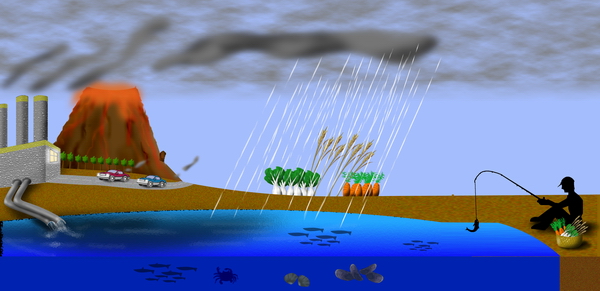
Food Safety Focus (14th Issue, September 2007) – Food Safety Platform
Overview of Metallic Contaminants in Food
Reported by Arthur YAU, Scientific Officer
Risk Communication Section, Centre for Food Safety
Introduction
Many different types of metals and metal compounds exist naturally in the earth's crust. Human activities, geological activities and other forces of nature may bring metals up to the surface and can increase the chance of human exposure to metallic contaminants. The history of such exposures goes back to pre-historic time, when humans were exposed to heavy metals via food and water in areas where the levels of heavy metals in the environment were naturally high. More recently, humans are exposed to metals as environmental pollutants from industrial or other human activities via food and water, among other things. This article is the introduction of a series of five articles on metallic contaminants in food.
Metallic Contaminants that are of Particular Concern in Human Diet
Four metals, namely lead, arsenic, cadmium and mercury, are of particular concern in food because of their toxicity, especially for long term (chronic) intake since they may accumulate in the body and cause organ damage particularly to susceptible groups such as foetuses and young children. Although acute poisoning from these metals is possible, it is more likely that it happens through non-food route. Each of these metals also forms numerous compounds with other elements, which vary in properties and levels of toxicity to humans when ingested. Other than through exposure in workplace, some of these metal contaminants enter our body mainly through the food we eat while others mainly enter our body through other means like from the air we breathe or from direct skin contact. We have reasonably good knowledge of the properties of these metallic contaminants as they have been evaluated by international authorities and safety reference values have been established.
Sources of Exposure to Metallic Contaminants
Of these four metals, lead can enter the body via a number of media including air, soil, water and food. Tobacco smoking, use of leaded petrol in vehicles, lead water pipe and leaded food can solder are reported to be major sources of lead exposure. Lead can be left on the surface of vegetables and/or absorbed into vegetables and cereals in areas where lead particles in air are deposited, and it can also bioaccumulate in aquatic food animals like shellfish and in offal of land animals.
Mercury exposure is also not limited to food. Besides diet, mercury exposure can occur through dental fillings that contain mercury compounds, occupational exposure and herbal medicines. Most dietary exposure is in the inorganic form. However, some large predatory fish like swordfish may bioaccumulate the more toxic organic form, methylmercury, in significant quantity.
Arsenic exposure occurs mainly through consumption of aquatic food, especially shellfish and animals that feed from the bottom of the sea. Trace amounts of arsenic may also enter food plants through the application of agricultural chemicals like fertilisers, which may contain arsenic.
Cadmium exposure occurs mainly through the diet. Food crops that are polluted through contaminated soil or water may contain high concentrations of the metal. Crustaceans, molluscs and kidneys of food animals are other possible dietary sources of cadmium, as they are more likely to accumulate the metal.
As these metallic contaminants of food may come from many different sources, it is more efficient to control contamination from these sources like the farms or factories that produce the pollution.
Illustration: Industrial discharge, exhaust from vehicles, volcanic activities, natural erosion from soil and agricultural chemicals are sources of metallic contaminants, which can in turn contaminate food crops, fish and shellfish.

Differences between Food Additives and Metallic Contaminants
The general public are often confused about different chemicals present in food. Food additives and metallic contaminants are two distinct types of chemicals. The major differences are summarized below.
| Food Additives | Metallic Contaminants | |
|---|---|---|
| Reason for its presence in food | Added, directly or indirectly, on purpose | Exist naturally or through contamination and often cannot be completely removed |
| Effect on food | Perform functions in food | No or little functions in food |
| Safety evaluation | Safety often evaluated by international authorities before being allowed to be used in food | Safety often evaluated by international authorities to minimise excessive exposure from food and other sources |
| Allowable concentration | Sufficient for the technological purpose | As low as reasonably achievable |
Risk Reduction Measures
Since metallic contaminants exist in a wide variety of food, maintaining a balanced diet is the most effective way to avoid excessive exposure to metallic contaminants from a small range of food items.


